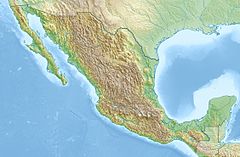
The National Autonomous University of Mexico is a public research university in Mexico. It is widely regarded as a top research university A portion of Ciudad Universitaria is a UNESCO World Heritage site that was designed and decorated by some of Mexico's best-known architects and painters of the 20th century. The campus also hosted the main events of the 1968 Summer Olympic Games. All Mexican Nobel laureates are alumni or faculty of UNAM. With acceptance rates usually below 10%, UNAM is known for its competitive admissions.
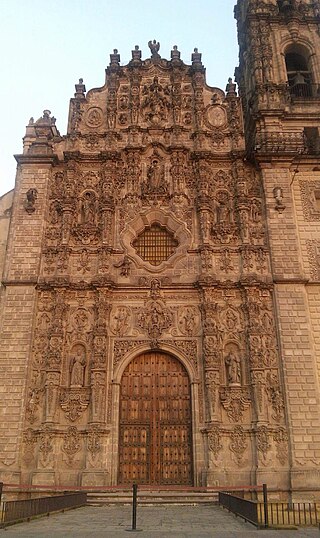
Tepotzotlán is a city and a municipality in the Mexican state of Mexico. It is located 40 km (25 mi) northeast of Mexico City about a 45-minute drive along the Mexico City-Querétaro at marker number 41. In Aztec times, the area was the center of a dominion that negotiated to keep most of its independence in return with being allied with the Aztec Triple Alliance. Later, it would also be part of a "Republic of the Indians," allowing for some autonomy under Spanish rule as well. The town became a major educational center during the colonial period when the Jesuits established the College of San Francisco Javier. The college complex that grew from its beginnings in 1580 would remain an educational center until 1914. Today this complex houses the Museo del Virreinato, with one of the largest collections of art and other objects from this time period.

Leonardo Nierman Mendelejis was a Mexican artist mostly known for his painting and sculpture. He at first wanted to be a violinist, but gave it up after twenty years when he compared a recording of his playing with that of Yehudi Menuhin. However, his musical training has been a major influence on his painting and sculpture, reproducing movement and harmony as Nierman sees similarities between the two disciplines. Nierman had had exhibitions in Mexico and abroad and over sixty recognitions of his work, half of which are from outside Mexico. His work is abstract but still with discernible images from nature such as birds, water, lightning and more. His paintings are in pure colors while his sculptures are generally of metal, often silver-toned.

The Caricature Museum is located in an 18th-century Baroque building in the historic center of Mexico City. It was opened in 1987 to preserve and promote the history of Mexican cartooning, done for both political and entertainment purposes. The historic building it occupies was originally the home of Cristo College, a royal college established in 1612.

Sebastián is a Mexican sculptor best known for his monumental works of steel and/or concrete in both Mexico and abroad. These include a number of “gate” sculptures such as the Gran Puerta a México in Matamoros, Tamaulipas but his most famous sculpture is the “Caballito” located in downtown Mexico City. His works are found in various countries outside Mexico, such as Japan where two are now used as city symbols.

Colegio de San Ildefonso, currently is a museum and cultural center in Mexico City, considered to be the birthplace of the Mexican muralism movement. San Ildefonso began as a prestigious Jesuit boarding school, and after the Reform War it gained educational prestige again as National Preparatory School. This school and the building closed completely in 1978, then reopened as a museum and cultural center in 1992. The museum has permanent and temporary art and archeological exhibitions in addition to the many murals painted on its walls by José Clemente Orozco, Fernando Leal, Diego Rivera and others. The complex is located between San Ildefonso Street and Justo Sierra Street in the historic center of Mexico City.
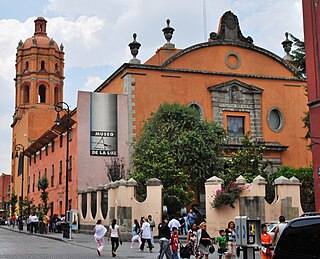
The San Pedro y San Pablo College is a colonial church located in the historical center of Mexico City, Mexico.

The Museo Nacional del Virreinato is located in the former College of San Francisco Javier in Tepotzotlán, Mexico State, Mexico. It belongs to Consejo Nacional para la Cultura y las Artes. The complex was built by the Aztecs, and used by the Jesuits starting in the 1580s. Three centers of learning were founded in the complex: a school to teach indigenous languages to Jesuit evangelists, a school for native boys, and the College of San Francisco Javier, to train Jesuit priests. The complex comprises three sections: the college area, with dormitories, a library, a kitchen, and a domestic chapel; the Church of San Francisco Javier; and the Church of San Pedro Apostol. The former college and the Church of San Francisco Javier have been converted into the Museo del Virreinato, with the former college area housing a large collection of art and ordinary objects from the colonial era, and the Church of San Francisco Javier housing one of the most important collections of Churrigueresque altarpieces in Mexico. The Church of San Pedro Apostol is the only part of the entire complex that is still used for religious purposes.

The Palacio de la Autonomía is a museum and site where the Universidad Nacional Autónoma de México gained autonomy from direct government control in 1929. The building is from the late 19th century, and located on the corner of Licenciado de Verdad and Rep de Guatemala streets, north of Santa Teresa la Antigua and east of Templo Mayor. The site has a 500-year history, starting from part of lands granted by Hernán Cortés. The current building was constructed by the administration of President Porfirio Díaz, but it was ceded to the university in 1910. Since that time, the building has had a number of uses, including housing a dental school and a preparatory school. Today it houses the Museo de la Autonomía Universitaria.
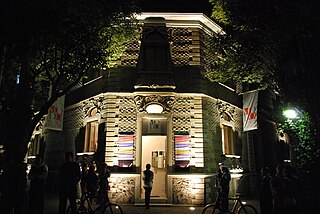
The Museo del Objeto del Objeto, or MODO, is a museum in Mexico City and the first museum in Mexico dedicated to design and communications. It was opened in 2010 based on a collection of commercial packaging, advertising, graphic arts, common devices and many other objects dating back to 1810 collected by Bruno Newman over more than 40 years. The museum is dedicated to the preservation of its collection of more than 30,000 items from two centuries and to the research in the history of design and communications.

Xavier Guerrero was one of the pioneers of the Mexican muralism movement in the early 20th century. He was introduced to painting through working with his father, who worked in masonry and decorating. However, there is evidence that his ability was mostly self-taught. In 1912, he moved to Guadalajara and began painting murals, then to Mexico City in 1919 just as the muralism movement was about to begin. Most of his work was in collaboration with or subordinate to other painters such as Diego Rivera and David Alfaro Siqueiros, working at the San Ildefonso College, the Secretaría de Educación Pública building and the Universidad Autónoma de Chapingo; however, much of his other work has been lost. While best known for his mural work, his later canvas work is considered to be better.

Jazzamoart is a Mexican artist best known for his painting which is mostly connected to jazz music in some way. Born Francisco Javier Vázques Estupiñán in Irapuato, Guanajuato, his talent was recognized early and he took his professional name from his dual passions of jazz and art. He is best known as a painter with over 400 individual and collective exhibitions on several continents, but he has also done monumental sculpture, stage scenery and has collaborated with musicians. He lives in Mexico City.
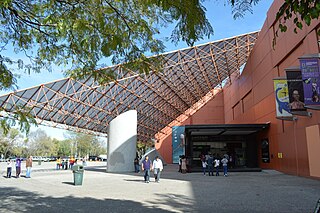
Universum is Mexico's primary museum dedicated to promoting science and technology to the public as well as support the university's science missions. It was opened in 1992 at the Ciudad Universitaria in Mexico City. Today it has thirteen halls divided by theme dedicated to various permanent exhibitions. It has worked with outside public and private entities to develop both permanent and temporary exhibitions and has worked to develop other science museums in other areas of the country.
Gustavo Arias Murueta was a Mexican painter, sculptor and poet, a member of the Salón de la Plástica Mexicana best known for his work in drawing, graphic arts and oil painting. He originally studied architecture at the Universidad Nacional Autónoma de México where he met artists such as Rufino Tamayo, David Alfaro Siqueiros and José Clemente Orozco. In the 1950s, he began to produce artworks, with his first exhibition in 1961. From then until his death he had a career as an artist with individual and collective exhibitions in both Mexico and abroad. While his work had been heavily influenced by Orozco, he was considered part of the Generación de la Ruptura movement.

The Museo Universitario del Chopo is located at Doctor Enrique González Martínez Street in the Colonia Santa María la Ribera of Mexico City. It has collections in contemporary art, and is part of the National Autonomous University of Mexico (UNAM).
Eliana Menassé is a Mexican painter and member of the Salón de la Plástica Mexicana, an honor society for Mexican artists

Vicente Gandía was a Mexican artist of Spanish origin who is best known for his depictions of nature and buildings. He originally trained to be an architect but abandoned this in favor of art, but with his art career beginning by drawing interiors. His major break came in 1968, with international expose which led to greater demand for his work. Recognitions for his art include membership in the Salón de la Plástica Mexicana, two awards from the same institution, a homage to the artist sponsored by the Instituto Nacional de Antropología e Historia while still alive and two others after his death, one with the Festival Internacional Cervantino.
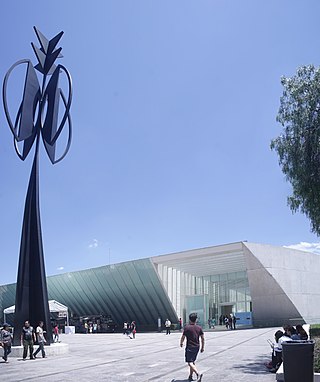
The Museo Universitario Arte Contemporáneo, also known as MUAC, is a large contemporary art museum located within the main campus of the National Autonomous University of Mexico (UNAM). It opened in November 2008 and it is the first Mexican public museum exclusively focused to the arts created in the XXI century.
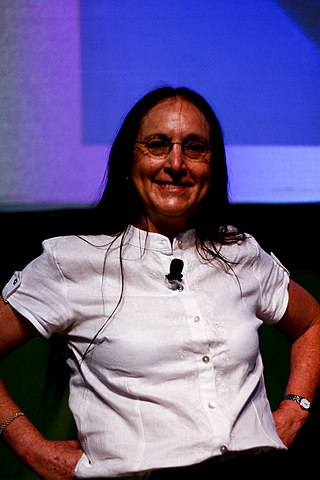
Julieta Norma Fierro Gossman best known as Julieta Fierro is a Mexican astrophysicist and science communicator. She is a full researcher at the Institute of Astronomy and professor of the Sciences Faculty at the National Autonomous University of Mexico (UNAM). She is part of the Researchers National System in Mexico, holding a level III position. Since 2004 she is a member of the Mexican Academy of Language.

